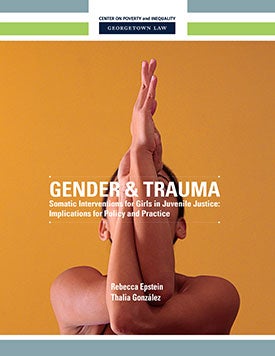Yoga Helps At-Risk Girls Cope with Trauma, Georgetown Law Report Finds
April 25, 2017
WASHINGTON – A report released today by Georgetown Law’s Center on Poverty and Inequality calls for specialized yoga programs to be offered widely to girls in the juvenile justice system amidst growing evidence that they can help them overcome the harmful effects of pervasive childhood trauma.
The first of-its kind report – which draws on original pilot studies in Pennsylvania and Connecticut, an extensive literature review, and interviews with experts and girls around the country – finds that tailored forms of yoga and mindfulness programs can be uniquely effective in supporting traumatized girls.
– which draws on original pilot studies in Pennsylvania and Connecticut, an extensive literature review, and interviews with experts and girls around the country – finds that tailored forms of yoga and mindfulness programs can be uniquely effective in supporting traumatized girls.
Benefits include better coping skills, increased emotional regulation, improved neurological and physical health outcomes, and healthier parenting practices and relationships, the report finds.
Children in the juvenile justice system have experienced disproportionately high rates of childhood trauma, which has long-term harmful effects on physical and mental health. Girls in the system are more likely than boys to have experienced all forms of abuse – but particularly sexual violence.
In light of evidence that trauma affects girls differently than boys, yoga interventions offer the juvenile justice system a cost-effective opportunity to address girls’ specific needs, the new report says.
“Girls in the juvenile justice system deserve support in healing and overcoming the devastating effects of childhood trauma that so many of them have experienced,” said lead author Rebecca Epstein, executive director of Georgetown Law’s Center on Poverty and Inequality. “Trauma-informed yoga is a powerful tool to help girls build a brighter future.”
Studies have shown that:
- Nearly two thirds of girls in the juvenile justice system (65%) show signs of post-traumatic stress disorder.
- Nearly twice as many girls as boys in the juvenile justice system reported past physical abuse (42% vs. 22%).
- More than a third of girls reported past sexual abuse (35%), as compared to 8% of boys.
- Four in five (80%) girls in the system show indications of at least one mental health diagnosis, as compared to two in three (67%) boys.
More than 40 published studies have evaluated the use of yoga and mindfulness to address mental health conditions. All, including controlled clinical trials, have reported positive benefits.
The Georgetown Law report finds that the proven benefits of yoga are well- positioned to mitigate the unique effects of trauma on girls. For instance:
- Yoga practice can restore neurological pathways in a region of the brain that processes emotion awareness, and decreases in size among female trauma survivors.
- Trauma-informed yoga can help girls overcome a feeling of disconnection to their body that is common among survivors of sexual violence.
The report emphasizes that yoga interventions should be trauma-informed and gender-responsive to be successful in the juvenile justice system. That can include instructors using invitational language to allow girls to feel in control of their practice, asking permission before engaging in physical contact and not approaching girls from behind.
Pilot studies conducted by Georgetown Law’s Center on Poverty and Inequality and results from programs in the juvenile justice system showed that after girls practiced trauma-informed yoga, they:
- Reported greater levels of self-esteem, self-respect and general wellbeing.
- Showed declines in anger, depression, flashbacks, nightmares and anxiety.
- Improved their ability to identify negative behavior patterns and resolve conflicts.
- Used breathing techniques to avoid aggressive responses to provocations by peers and to manage the stress of appearing in court.
- Reported past incidents of sexual violence to staff.
Additionally, the report finds that trauma-informed yoga is cost-effective and sustainable. It cites successful and innovative regional programs developed in Palo Alto, Calif. and Brookline, Mass.
In order to have the greatest impact on girls in the juvenile justice systems, the reports’ authors provide these recommendations:
- Build on existing law. Interpret existing health laws to allow yoga and mindfulness programs to be introduced into juvenile justice settings. The report cites promising laws in Louisiana and Nebraska.
- Expand access. Evaluate existing programs and develop new ones that are geared to the unique needs of girls in the juvenile justice system who have experienced trauma. Also include sensitivity to race, ethnicity, sexual orientation, and gender identity in their design.
- Increase funding and research. Support effective yoga and mindfulness programs with funding and continue to build the research base.
“Yoga is already helping girls in custody manage their emotions, build resilience and recognize the potential they have to improve their own lives,” said Thalia González, the report’s coauthor. “By expanding the reach of these powerful, low-cost programs, the juvenile justice system could help many more struggling girls overcome the harrowing pasts they have endured.”
Download a copy of the new report: Gender & Trauma – Somatic Interventions for Girls in the Juvenile Justice: Implications for Policy and Practice